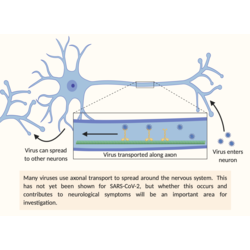By Ella Hopkins
I have been writing about coronavirus for the past few blog posts as I felt there was a need to break down recent literature into bite-sized chunks that could appeal to a wide audience, from the general public to current researchers. This is, however, a blog site for the Coleman lab – which primarily researches Wallerian degeneration – so we were very interested to read of a possible connection between axonal disorders and coronavirus. This article outlines the early studies that suggest this.
In most people, the coronavirus (SARS-CoV-2) infects the lungs and causes a dry cough, but the immune system fights off the infection after a few weeks. In this scenario, the virus does not spread elsewhere in the body. Unfortunately, in some people, the virus can infect other areas of the body; this is when the disease can become more serious and some may need to go to hospital for treatment. 
There has been an increasing number of reports in the past few weeks about SARS-CoV-2 infecting the nervous system and causing neurological symptoms. This is so far happening in very few cases, as far as we are aware, and most reports have not yet been peer-reviewed or published in journals. Fortunately, more research is being published daily in this area of COVID-19 study.
In one report from NEJM, five COVID-19 patients out of an estimated 1000-1200 admitted to three hospitals in Northern Italy later developed symptoms of Guillain-Barré syndrome (GBS). GBS is caused by the immune system attacking the peripheral nervous system. It can cause severe muscle weakness and leads to some requiring mechanical ventilation to breathe. Its exact causes are unknown, but infection by several other viruses are known risk factors. A recent prominent example of a virus that may cause GBS is Zika – around 1.23% of Zika cases are associated with GBS according to a meta-analysis by King’s College London.
More worryingly, results published in JAMA found 36.4% of 214 COVID-19 patients in Wuhan were found to have ‘neurologic symptoms’. This included milder symptoms such as dizziness (16.8%) and headaches (13.1%) , as well as more serious symptoms such as acute cerebrovascular disease (includes ischemic stroke and cerebral haemorrhage; 5.6%) and seizures (0.5%). Of note though, is that many of these neurologic symptoms were seen in patients with severe infection, who tended to be older and had other underlying disorders. In some patients followed by this study, neurological symptoms developed before COVID-19 symptoms, highlighting the importance of testing all hospital admissions for COVID-19.
According to a study by Lu et al., there does not appear to be an onset of seizures as a result of COVID-19 infection, in patients with no history of seizures. It seems likely that the seizures seen in 0.5% of cases in the JAMA report is most likely someone with a pre-existing seizure condition that was not previously diagnosed.
SARS-CoV-2 has been detected in the cerebrospinal fluid of patients, leading to hypotheses that SARS-CoV-2 could cause meningoencephalitis. There have been two reported cases of patients (that I could find) who were COVID-19 positive and had meningoencephalitis. This included a tragic report of a 5 year-old girl who died.
These emerging cases shine a light to some of the less well-known symptoms and resulting disorders that COVID-19 can cause. Close monitoring of patients in hospital with COVID-19 and of new hospital admissions is necessary to ensure that everyone is given correct treatments and gets the best quality of care. Additionally, further study is needed to determine how best to halt SARS-CoV-2 infection into the nervous system and to reduce the incidence and severity of neurological symptoms of COVID-19.
Whilst the Coleman Lab does not directly study neurological disorders caused by viruses like SARS-CoV-2, our research on Wallerian degeneration could link into some of the disorders observed. Neurons, or their axons, will die after stroke, for example, or when the immune system attacks peripheral neurons in GBS. Whether neuronal death from COVID-19 involves Wallerian degeneration remains to be discovered, but nonetheless it is important to study programmed axon death as it could lead to developing therapies for people with neurological diseases.
